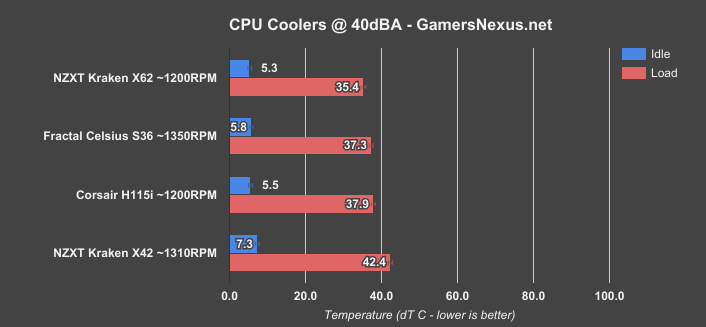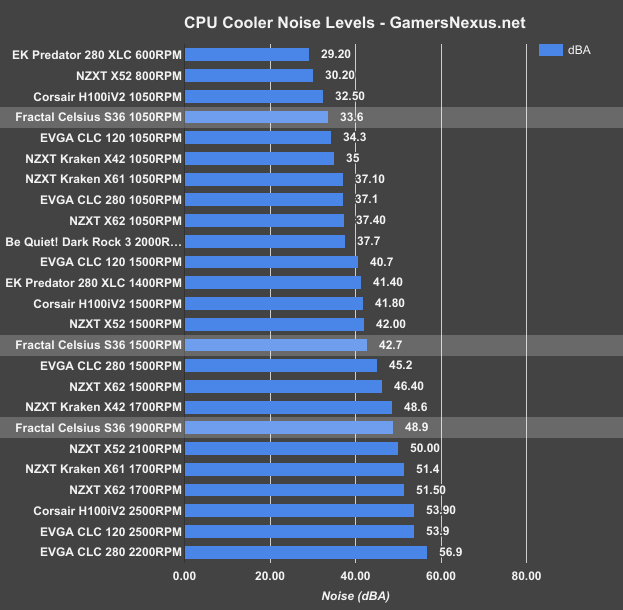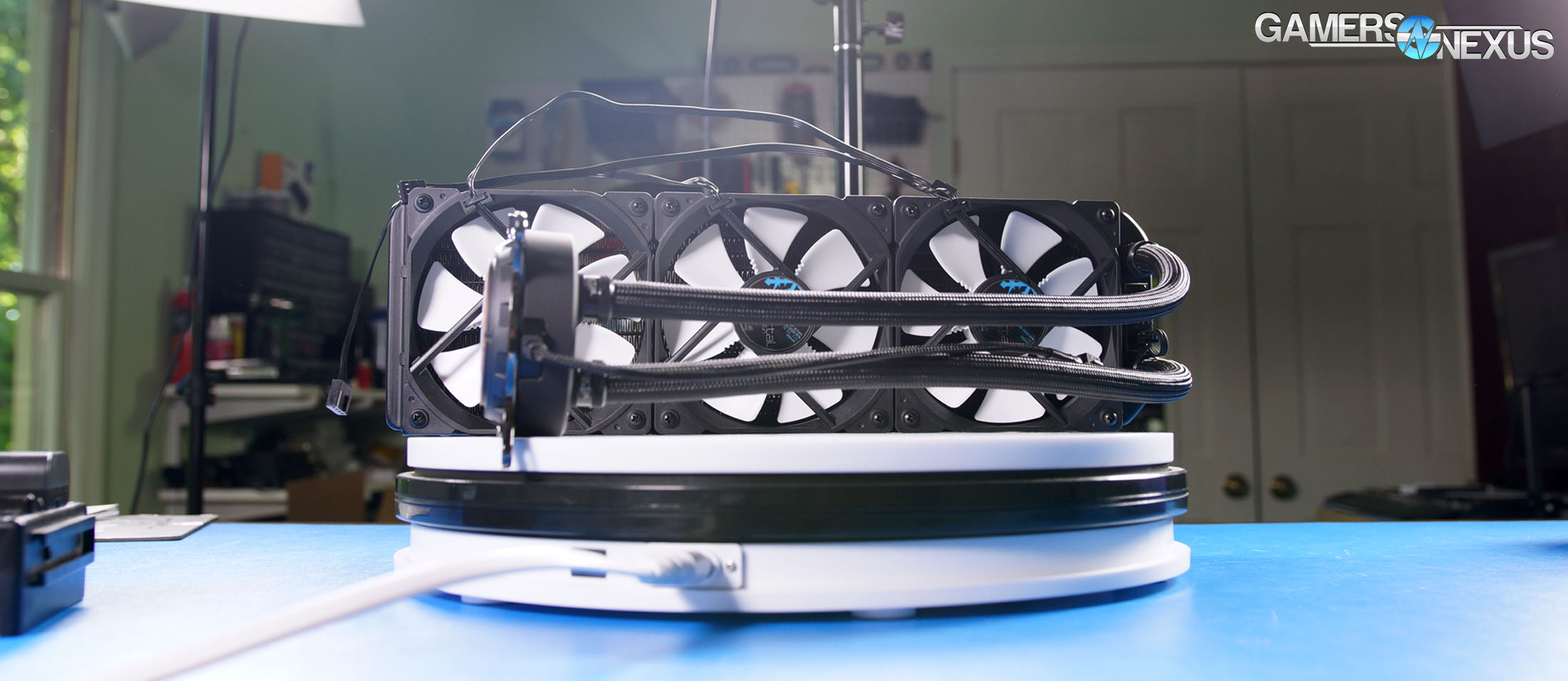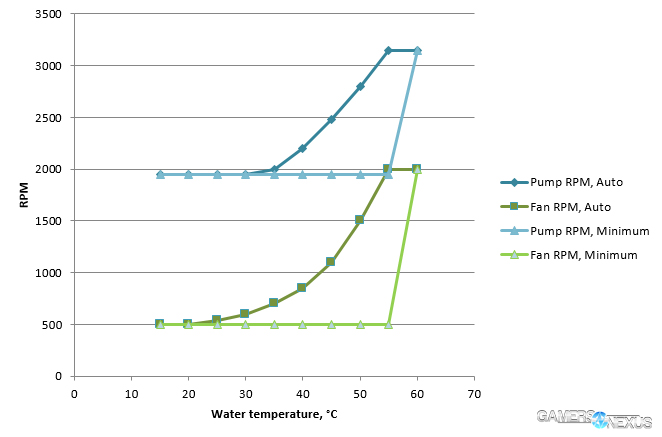Fractal’s Celsius S36 debuts alongside the company’s S24, coolers sized at 360mm and 240mm, respectively. The Celsius series uses an Asetek Gen5 pump, identical to the pump found on the EVGA CLC, NZXT X42/52/62, and Corsair H115i/H100iV2 coolers. This is a semi-custom Asetek solution that’s been loosely customized by Fractal Design, primarily focusing on the addition of G1/4” fittings (rad-side only), on-pump speed tuning, and an on-rad fan hub. It’s not as customized as, say, the NZXT Kraken series, but NZXT’s products also run more expensive. Fractal is looking at a launch price of $120 for the S36 that we’re reviewing today, and $110 for the S24.
Our focuses are on thermals and noise – not that you can focus on much else when talking coolers – with some new testing that looks at normalized noise output. We debuted this testing in our ASUS ROG Strix review and have carried it over to coolers.
Fractal’s coolers use 120mm fans that run a maximum RPM nearing 2000, with variable pump RPM from ~2000~3000. In our testing, though, it seemed a little simpler than that – pump RPM is based on liquid temp, and as we found in our 7700K review (the hottest CPU we've tested), liquid temp never really exceeds 30C. Given Fractal's curve, that means the pump stays at 2000RPM almost all the time. Rather than use software or suggest straight BIOS control – which we prefer – Fractal’s gone with a toggleable pump plate that switches into auto or PWM options. We’ve tested variable pump speeds in the past and haven’t found major differences in cooling efficacy, which is more heavily relegated to the fan spec and radiator size than anything else. This is more of a noise impact. We tested using the default, out-of-box “auto” setting, which kept our pump RPM fixed nearly perfectly at ~1960 throughout the tests (liquid temperature doesn't ramp up enough to push higher).
Fan speeds were manually controlled for the tests, though users could connect the fans to the on-rad hub. More on this in the conclusion.
Let’s get on with the testing, then run through the accessories and conclusion.
CPU Cooler Testing Methodology
CPU cooler testing is conducted using the bench defined below. We use a bench that is more carefully crafted for noise performance, opting for a passively cooled PSU and 23% RPM 980 Ti blower fan for very low system noise.
We strongly believe that our thermal testing methodology is among the best on this side of the tech-media industry. We've validated our testing methodology with thermal chambers and have proven near-perfect accuracy of results.
Conducting thermal tests requires careful measurement of temperatures in the surrounding environment. We control for ambient by constantly measuring temperatures with K-Type thermocouples and infrared readers. Two K-Type thermocouples are deployed around the test bench: One (T1) above the bench, out of airflow channels, and one (T2) approximately 2-3" in front of the cooler's intake fan. These two data points are averaged in a spreadsheet, creating a T3 value that is subtracted second-to-second from our AIDA64 logging of the CPU cores.
All six CPU cores are totaled and averaged second-to-second. The delta value is created by subtracting corresponding ambient readings (T3) from the average CPU core temperature. We then produce charts using a Delta T(emperature) over Ambient value. AIDA64 is used for logging thermals of silicon components, including the CPU and GPU diodes. We additionally log core utilization and frequencies to ensure all components are firing as expected. Voltage levels are measured in addition to fan speeds, frequencies, and thermals.
The cores are kept locked to 3.8GHz (x38 multiplier). VCore voltage is locked to 1.141v for the CPU. C-States are disabled, as is all other power saving. The frequency is locked without any interference from boost or throttle functions. This is to ensure that the CPU does not undergo any unexpected/uncontrollable power saving or boost states during testing, and ensures that the test platform remains identical from one device to the next.
Fan speeds are manually controlled unless otherwise defined. For liquid coolers, pumps are set to 100% speed unless otherwise defined.
No open bench fans are used for these CPU cooler tests. Only fans which are provided with the cooler are used.
| GN Test Bench 2015 | Name | Courtesy Of | Cost |
| Video Card | GTX 980 Ti Reference 23% RPM | NVIDIA | EOL |
| CPU | Intel i7-5930K CPU @ 3.8GHz | iBUYPOWER | $580 |
| Memory | Corsair Vengeance 32GB 2666MHz | Corsair | $175 |
| Motherboard | EVGA X99 Classified | GamersNexus | $365 |
| Power Supply | Enermax DigiFANLESS | Enermax | $250 |
| SSD | HyperX Savage SSD | Kingston Tech. | $130 |
| Case | Top Deck Tech Station | GamersNexus | $250 |
| CPU Cooler | This is what we're testing! | - | - |
We use an AMPROBE multi-diode thermocouple reader to log ambient actively. This ambient measurement is used to monitor fluctuations and is subtracted from absolute GPU diode readings to produce a delta value. For these tests, we configured the thermocouple reader's logging interval to 1s, matching the logging interval of GPU-Z and AIDA64. Data is calculated using a custom, in-house spreadsheet and software solution.
Our test starts with a 180s idle period to gauge non-gaming performance. A script automatically triggers the beginning of a CPU-intensive benchmark running Prime95 LFFTs. Because we use an in-house script, we are able to perfectly execute and align our tests between passes.
Fractal Celsius S36 Benchmark at 40dBA vs. EVGA CLC 280, X62, H115i
Our first test initializes the review with just a few of the coolers – we’ll add more than a dozen tests to the chart in a moment.
This chart is on the tail of our ASUS ROG Strix review, which introduced noise-normalized temperature testing at a fixed dBA output. Here, we’re testing the H115i, Kraken X62, Kraken X42 for perspective, and Fractal Celsius S36 at a fixed noise output of roughly 40dBA. This helps us determine cooling efficacy at a known noise level, equalizing for some product differences.
The difference between Fractal and Corsair is within our range of uncertainty, meaning that the two are effectively equal in temperature performance at 40dBA. Each unit reads-out a delta T value of about 37-38C over ambient, with idles at 5.5-6C delta T over ambient. The Kraken X62 is at 35.4C delta T for a 2-3C lead, and although this is measurable, it’s not necessarily a game-changer. An extra 2C off the CPU won’t change performance at this level. That said, it does mean that we could run a lower fan curve, like one that meets 38-39dBA, and achieve equal performance to Fractal and Corsair.
The X42 is a 140mm cooler, making it the smallest on the bench – the H115i and X62 are 280mm, the S36 is 360. The X42 is really just there for perspective, where we see a 42C delta T at 40dBA, with 2C warmer idle temperatures.
Fractal Celsius S36 Temperatures vs. All
Let’s flood the chart with more data, but keep the Fractal Celsius coolers highlighted for ease.
At maximum RPM, the Fractal S36 360mm radiator runs its fans at approximately 1900RPM, landing its thermal performance at around 36C delta T over ambient load. We’re producing a noise output of about 49dBA at this point – fairly loud – while ranking about where the Corsair H115i and Kraken X62 at 1500RPM stand. The X62 at 1500RPM measures about 46.4dBA in our noise test, making it a little quieter than the Fractal S36 at max RPM.
Fractal’s maximum cooling capacity is lower than the 280mm coolers in the top 3 slots on the bench, in our testing, though fills a middle-of-the-pack performance range from 40C delta T to 36C delta T. At 1050RPM, Fractal’s S36 is able to maintain a 40C delta T load temperature alongside a 33.6dBA output. This is similar in thermal performance to the Kraken X52 at 1500RPM, with a 42dBA output.
The larger radiator helps in this regard, maintaining lower noise levels at a still acceptable temperature. The EVGA CLC 280 costs $120 and maintains a temperature of about 40C delta T with a 1050RPM speed, outputting a noise level of about 37.1dBA. This is the most comparable to Fractal’s low-RPM performance, though is still louder.
There’s another trade between the S36 at 1500RPM – or about 42.7dBA – and the X62 at 1050RPM, or about 37.4dBA. Thermally, these two perform effectively equally on our chart – but the X62 is quieter when both are around 37C delta T load temperatures.
Fractal Celsius S36 Noise Levels
Fractal is competitive at around 1050RPM to 1300RPM, where it makes the best argument in terms of noise-to-cooling performance. It’s performing right alongside an H100iV2 at 1050RPM, but offers better cooling performance.
Conclusion: Fractal Celsius Not Fully Thought Through
Once you’ve seen one Asetek Gen5 pump, you’ve really seen all of them. And we’ve seen multiple up-close (X42 tear-down, EVGA CLC tear-down). Performance isn’t going to be all that different between any of these if equalizing for fans. The real difference emerges from fans, and even that’s not much of a thermal game-changer. The 280mm CLCs tend to take top-ranks when maxed out on DC power to the fans, with Fractal’s 360mm solution rounding-out the middle of the pack. Fractal has some acoustics advantages at some specific RPMs, but to be fair, that can be said of almost all these coolers.
We’re left to differentiate between products by only two real factors when comparing Asetek products: Fan quality, which we did above, and “extras.” Fractal has a lot of those.
Above: Provided by Fractal to GamersNexus.
The mechanical action for the pump speed isn’t particularly reassuring; it doesn’t offer that haptic “click” each time, and it’s a completely impractical feature. This is something you do once, then never touch again – at least, not unless it’s an open bench. If we’re only setting a pump speed one time, it seems there’s probably a better solution: BIOS. Just set it there. Easy. There’s not much point in adding a one-time use mechanical switch. Further, because Fractal is basing off of liquid temperature, the pump will mostly stay at 2000RPM forever. Liquid temperatures almost never go above 29-30C on these Asetek coolers. We’ll give that it’s a unique idea, at least.
The fan hub is Fractal’s most defining feature, given the overall impracticality of its pump toggle. The idea is that this helps with cable management, something Fractal’s obviously keen on, given the internal cable routing within the tube sleeves. Unfortunately, regardless of configuration, we were unable to get the farthest fan to cleanly connect with the hub (and yes, we tried both sides of the radiator, both orientations of the fan). It can connect, but then you’re running a cable under or over the other fans. If going as far as adding cable management features, it doesn’t make sense to spoil them with unclean routing. An extra 0.25-0.5” cable length would solve this.
As for the G1/4” fittings, they’re also of mixed usefulness. The fittings are only on the radiator side of the cooler, with veneer fittings – fakes, basically – on the pump-side. It is not possible to fully replace the tube. People run open loops largely for looks. Very few people – although some certainly will – would actively seek a CLC that can be half-opened, but will be stuck with the original black, braided tubes. And those braided tubes do look nice – on a closed-loop cooler. It’s just doesn’t demonstrate a strong understanding of why open loops exist when we’re assuming the builder will mix tubes of various colors and designs. Ignoring that and looking at practicality, Fractal loses ground there, too; an EK solution, should you really seek some half-open/half-closed amalgam, would offer easier to use QDCs. Even then, if you’re going open loop, you might as well just do the whole thing. This is a closed-loop cooler. It might pretend to offer open-loop functionality, but that’s not its core focus. Besides, Fractal has “warranty void” stickers on the G1/4” fittings. We understand why they’re there, but from our perspective, you support a product for its advertised features. If customization for inclusion in other loops is a major selling point, you stand by that bullet on the box.
Regardless, the G-1/4” fittings are another instance of “good idea that’s not been thought through.”
EVGA fiercely competes at $120 with its CLC 280, Corsair is in the $140 range with the H115i, and NZXT holds the priciest bracket with the X62. Fractal, meanwhile, is stopping short of greatness each step of the way, and it’s going to mean someone else swoops in and develops on those strong foundations.
Editor-in-Chief: Steve Burke
Video Producer: Andrew Coleman




